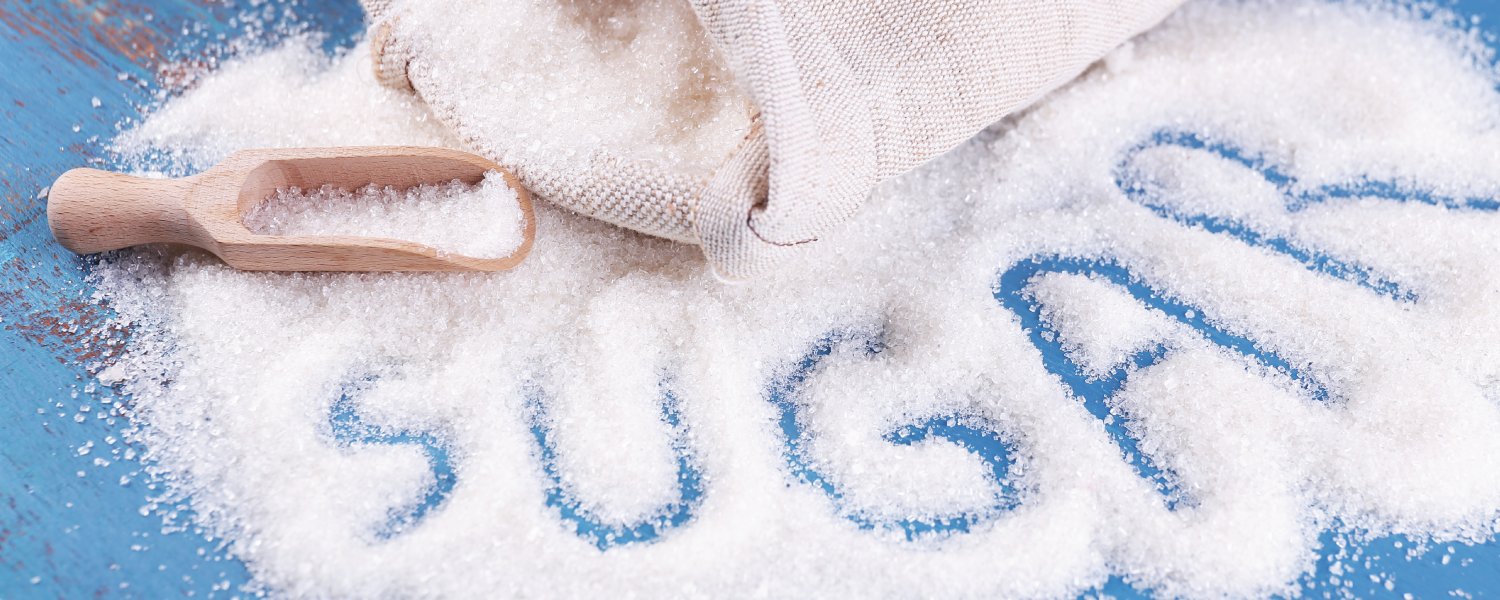Have you ever considered how much sugar you consume in a day?
Or even the amount you or your children may consume before noon?
Let’s just lay out a “typical” start to the day…
Breakfast:
A Tim Hortons Cinnamon Raisin bagel (11 grams)1 with plain cream cheese (2 grams)1, Double-Double Coffee (18 grams)1 = 31 grams of sugar
or
1.25 cups of Kellogg’s Vector Cereal (11 grams)2 with 1 cup 1% Milk (14 grams)3, and a banana (17 grams)4 = 42 grams of sugar
or
2 Slices of Dempsters 100% Whole Wheat Bread/Toast (6 grams)5 with 2 Tbsp Kraft All Natural Peanut Butter (2 grams)6 and 2 Tbsp Smuckers Strawberry Jam (22 grams)7, with 8 oz orange juice (24 grams)8 = 54 grams of sugar
Morning Snack:
Nutri-Grain Bar = 13 grams of sugar9
or
Jamba Juice Sunrise Banana Berry = 59 grams of sugar10
And before you even get to lunch, you may have consumed well over 50 grams of sugar!!
As we reported in last week’s blog, The University of Texas MD Anderson Cancer Centre advises that women should consume no more than 25 grams of sugar per day, and men should consume no more than 37 grams of sugar per day.11
So depending on what food you choose to start your day with, you are potentially well over the recommended daily allowance before noon!
But what is the problem with Sugar? Why is it a concern?
Sugar is an anti-nutrient. It leaches nutrients from the body in your attempt to clean up the damage that sugar leaves behind. It also directly feeds cancer cells,12 and causes major inflammation in the body.
Inflammation is the cause behind many, many illnesses and conditions, and sugar fuels inflammation rather effectively. Because of its oxidative effect on the body, it can contribute to a whole host of conditions and issues that may be misdiagnosed as other illnesses or causes, but in actuality, the cause is actually consuming sugar.
Here is a partial list of some of the problems that sugar causes in the body13:
Sugar can:
1. Suppress the immune system.
2. Upset the mineral relationships in the body.
3. Cause hyperactivity, anxiety, difficulty concentrating, and crankiness in children.
4. Produce a significant rise in triglycerides.
5. Contribute to the reduction in defense against bacterial infection (infectious diseases).
6. Cause a loss of tissue elasticity and function. The more sugar you eat the more elasticity and function you loose.
7. Reduce high-density lipoproteins.
8. Lead to chromium deficiency.
9 Lead to cancer of the ovaries.
10. Increase fasting levels of glucose.
11. Cause copper deficiency.
12. Interfere with absorption of calcium and magnesium.
13. Weaken eyesight.
14. Raise the level of neurotransmitters: dopamine, serotonin, and norepinephrine.
15. Cause hypoglycemia.
16. Produce an acidic digestive tract.
17. Cause a rapid rise of adrenaline levels in children.
18. Cause malabsorption – frequent in patients with functional bowel disease.
19. Cause premature aging.
20. Lead to alcoholism.
21. Cause tooth decay.
22. Contribute to obesity
23. Increases the risk of Crohn’s disease and ulcerative colitis.
24. Cause changes frequently found in person with gastric or duodenal ulcers.
25. Cause arthritis.
26. Cause asthma.
27. Greatly assist the uncontrolled growth of Candida Albicans (yeast infections).
28. Cause gallstones.
29. Cause heart disease.
30. Cause appendicitis.
Sugar can cause so many more health problems.
What is the Solution?
Avoid processed and fast foods, convenience foods and packaged foods.
Choose foods that are low on the glycemic index, in their whole form, that you recognize are the same in the field, as in the grocery store. Choose vegetables, raw nuts and seeds, legumes, grass fed, free range, organic meat and poultry. Have a shake in the morning with berries, superfoods and coconut or almond milk. Plan your meals for the week so that you are in control of the fuel you consume, and you will feel so much more energetic and be so much more healthy!
…And just to top it off with a “sweet” ending, the next time you head toward Dairy Queen this summer, just remember that a Medium Butterfinger Blizzard has 86 grams of sugar!14
____________________________________
Jo-Anne Richardson, Registered Holistic Nutritionist & Energy Medicine Practitioner
Jo-Anne works with Fournier Homeopathic & Integrative Health to provide online education for clients and patients. Her interest in healthy, joyful living is demonstrated in her writing, coaching and teaching. Her goal is to improve the health of her community by empowering you with knowledge, support and new ideas.
Looking for more tips and information on holistic health and living? Like our Facebook page at https://www.facebook.com/FournierHealth and follow us on Twitter https://twitter.com/FournierHealth
With Sources from:
1 – https://www.timhortons.com/ca/en/pdf/TH_Nutrition_Guide_CE_2013_-_FINAL.pdf
2 – http://www.kelloggsvector.ca/en_CA/products/meal-replacement.html#nutrition-modal
3 – http://www.healthyeating.org/Milk-Dairy/Dairy-Facts/Sugar-in-Milk.aspx
4 – http://www.sugarstacks.com/fruits.htm
5 – https://www.dempsters.ca/products/dempsters®-100-whole-wheat-bread
6 – http://www.kraftcanada.com/products/00068100084665
7 – http://www.smuckers.ca/Products/Jams-Jellies-and-Fruit-Spreads/Pure-Jam/Pure-Strawberry-Jam
8 – http://www.sugarstacks.com/beverages.htm
9 – http://www.sugarstacks.com/breakfast.htm
10 – http://www.sugarstacks.com/shakes.htm
11 – https://www.mdanderson.org/publications/focused-on-health/may-2015/FOH-cancer-love-sugar.html
12 – http://www.mercola.com/article/sugar/sugar_cancer.htm
13 – http://www.rheumatic.org/sugar.htm
14 – http://www.sugarstacks.com/shakes.htm
Here are the sources from the excerpted list of 146 Reasons Why Sugar is Ruining Your Health:
1. Sanchez, A., et al. “Role of Sugars in Human Neutrophilic Phagocytosis,” American Journal of Clinical Nutrition. Nov 1973;261:1180-1184.
Bernstein, J., et al. “Depression of Lymphocyte Transformation Following Oral Glucose Ingestion.” American Journal of Clinical Nutrition.1997;30:613.
2. Couzy, F., et al.”Nutritional Implications of the Interaction Minerals,” Progressive Food and Nutrition Science 17;1933:65-87.
3. Goldman, J., et al. “Behavioral Effects of Sucrose on Preschool Children.” Journal of Abnormal Child Psychology.1986;14(4):565-577.
4. Scanto, S. and Yudkin, J. “The Effect of Dietary Sucrose on Blood Lipids, Serum Insulin, Platelet Adhesiveness and Body Weight in Human Volunteers,” Postgraduate Medicine Journal. 1969;45:602-607.
5. Ringsdorf, W., Cheraskin, E. and Ramsay R. “Sucrose,Neutrophilic Phagocytosis and Resistance to Disease,” Dental Survey. 1976;52(12):46-48.
6. Cerami, A., Vlassara, H., and Brownlee, M.”Glucose and Aging.” Scientific American. May 1987:90.
Lee, A. T. and Cerami, A. “The Role of Glycation in Aging.” Annals of the New York Academy of Science. 663:63-67.
7. Albrink, M. and Ullrich I. H. “Interaction of Dietary Sucrose and Fiber on Serum Lipids in Healthy Young Men Fed High Carbohydrate Diets.” American Journal of Clinical Nutrition. 1986;43:419-428.
Pamplona, R., et al. “Mechanisms of Glycation in Atherogenesis.” Medical Hypotheses. Mar 1993;40(3):174-81.
8. Kozlovsky, A., et al. “Effects of Diets High in Simple Sugars on Urinary Chromium Losses.” Metabolism. June 1986;35:515-518.
9. Takahashi, E., Tohoku University School of Medicine, Wholistic Health Digest. October 1982:41.
10. Kelsay, J., et al. “Diets High in Glucose or Sucrose and Young Women.” American Journal of Clinical Nutrition. 1974;27:926-936.
Thomas, B. J., et al. “Relation of Habitual Diet to Fasting Plasma Insulin Concentration and the Insulin Response to Oral Glucose,” Human Nutrition Clinical Nutrition. 1983; 36C(1):49_51.
11. Fields, M.., et al. “Effect of Copper Deficiency on Metabolism and Mortality in Rats Fed Sucrose or Starch Diets,” Journal of Clinical Nutrition. 1983;113:1335-1345.
12. Lemann, J. “Evidence that Glucose Ingestion Inhibits Net Renal Tubular Reabsorption of Calcium and Magnesium.” Journal Of Clinical Nutrition. 1976 ;70:236-245.
13. Acta Ophthalmologica Scandinavica. Mar 2002;48;25.
Taub, H. Ed. “Sugar Weakens Eyesight,” VM NEWSLETTER;May 1986:6
14. “Sugar, White Flour Withdrawal Produces Chemical Response.” The Addiction Letter .Jul 1992:4.
15. Dufty, William. Sugar Blues. (New York:Warner Books, 1975).
16. Ibid.
17. Jones, T. W., et al. “Enhanced Adrenomedullary Response and Increased Susceptibility to Neuroglygopenia: Mechanisms Underlying the Adverse Effect of Sugar Ingestion in Children.” Journal of Pediatrics. Feb 1995;126:171-7.
18. Ibid.
19. Lee, A. T.and Cerami A. “The Role of Glycation in Aging.” Annals of the New York Academy of Science.1992;663:63-70.
20. Abrahamson, E. and Peget, A.. Body, Mind and Sugar. (New York:Avon,1977.}
21. Glinsmann, W., Irausquin, H., and Youngmee, K. “Evaluation of Health Aspects of Sugar Contained in Carbohydrate Sweeteners. F. D. A. Report of Sugars Task Force.” 1986:39.
Makinen K.K.,et al. “A Descriptive Report of the Effects of a 16_month Xylitol Chewing_Gum Programme Subsequent to a 40_Month Sucrose Gum Programme.” Caries Research. 1998; 32(2)107-12.
Riva Touger-Decker and Cor van Loveren, “Sugars and Dental Caries.”
[if !supportEmptyParas] [endif]
Am. J. Clin.Nut. Oct 2003; 78:881-892.
22. Keen, H., et al. “Nutrient Intake, Adiposity, and Diabetes.” British Medical Journal. 1989; 1: 655-658.
23. Tragnone, A. et al. “Dietary Habits as Risk Factors for Inflammatory Bowel Disease.” Eur J Gastroenterol Hepatol. Jan 1995;7(1):47-51.
24. Yudkin, J. Sweet and Dangerous.. (New York;Bantam Books:1974), 129.
25. Darlington, L., Ramsey, N. W. and Mansfield, J. R. “Placebo_Controlled, Blind Study of Dietary Manipulation Therapy in Rheumatoid Arthritis,” Lancet. Feb 1986;8475(1):236-238.
26. Powers, L. “Sensitivity: You React to What You Eat.” Los Angeles Times. Feb. 12, 1985.
Cheng, J., et al. “Preliminary Clinical Study on the Correlation Between Allergic Rhinitis and Food Factors.” Lin Chuang Er Bi Yan Hou Ke Za Zhi Aug 2002;16(8):393-396.
27. Crook, W. J. The Yeast Connection. (TN:Professional Books, 1984)..
28. Heaton, K. “The Sweet Road to Gallstones.” British Medical Journal. Apr 14, 1984; 288:1103-1104.
Misciagna, G., et al. American Journal of Clinical Nutrition. 1999;69:120-126.
29. Yudkin, J. “Sugar Consumption and Myocardial Infarction.” Lancet..Feb 6, 1971;1(7693):296-297.
Reiser, S. “Effects of Dietary Sugars on Metabolic Risk Factors Associated with Heart Disease.” Nutritional Health. 1985;203-216.
30. Cleave, T. The Saccharine Disease. (New Canaan, CT: Keats Publishing, 1974).
Nancy Appleton
P.O. Box 3083
Santa Monica
CA 90403






Leave A Comment